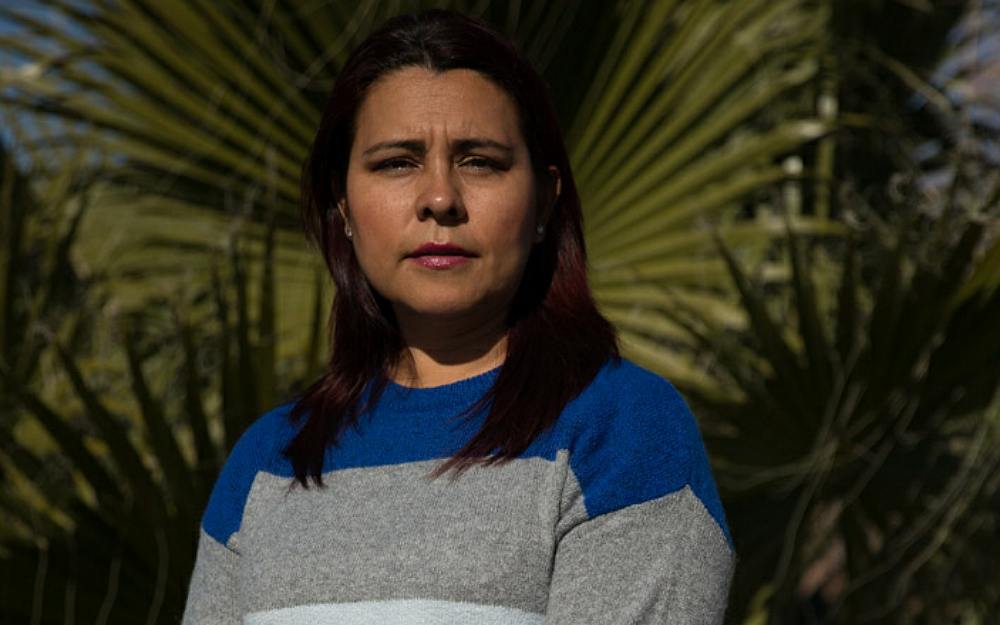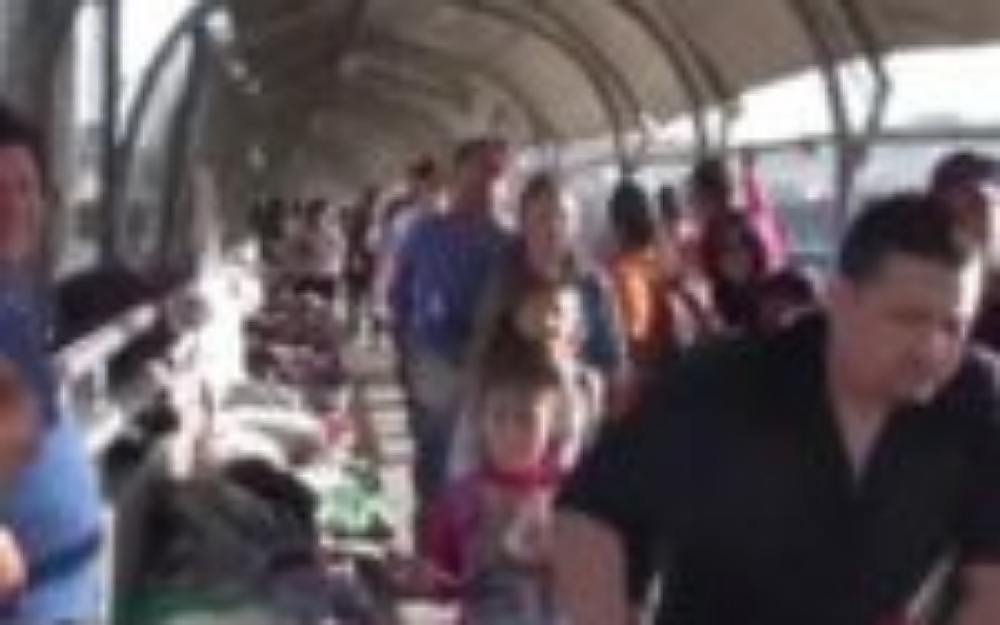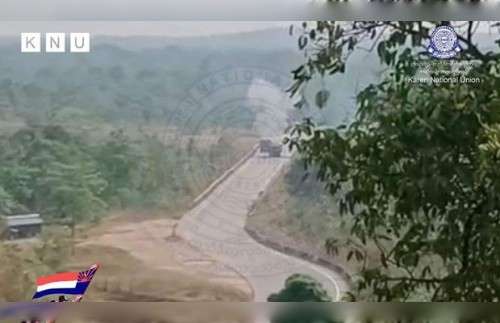As corporations cash in, mixed-status families are thrown into deep poverty
Jessica Kutz/High Country News
In March 2009, at dinnertime, Myrna Obeso got a call at her house in Tucson, Arizona. At first, the busy mother of two didn’t pick up. Robo-callers were always bugging the family at that time of night. On this particular evening, the caller was more persistent than usual. Exasperated, she finally answered.
“Pima County Jail,” a recorded voice said.
As her mind struggled to make sense of the call, another voice came through: that of her husband, Gustavo Velasco. He was supposed to be at his second job, working nights as a cook at a nearby restaurant.
For years, Velasco had been using a fraudulent Social Security number. This was back before E-Verify — a government tool that allows employers to verify work documents — when jobs were easy to find if you could supply convincing documents.
A couple of years before, however, the state passed laws resulting in undocumented residents caught using fake documents to be charged with felony identity theft. Previously, the felony charges were used to prosecute people who benefited from fraudulent documents to do things like rack up credit card debt, not those who were merely seeking jobs. Advocates like Puente Arizona, a migrant justice organization, say the changes were aimed specifically at undocumented workers. Because of these laws, former Maricopa County Sheriff Joe Arpaio was able to charge hundreds of undocumented workers with felonies during his controversial workplace raids.
Velasco’s arrest that March 2009 night would also end in a felony charge. He spent five months in the Pima County Jail and was eventually offered a $10,000 bail. But because Velasco was undocumented, he not only had to fight those charges, he had to fight his detention and possible deportation. The time he spent inside Eloy Detention Center, in the cactus-speckled desert of rural Arizona, exacted a psychological toll on him. He never knew how long he’d be locked up, or if he’d be deported; in fact, he still doesn’t. But the financial impact on his wife and two children — and the life they had built here in the U.S. — would prove equally devastating.

UNTIL VELASCO’S ARREST, Obeso was a stay-at-home mother raising two elementary-age children. During the five months he spent inside a jail cell, she was suddenly left scrambling to pay bills while raising money for his bond. “I was paying for rent and utilities, everything,” she told me from her festively decorated living room. She emptied their saving accounts — they had been on track to buy a house — and sold their car. She started selling manicures, baked goods and Mexican desserts like flan, as well as the silver jewelry that a friend gave her in order to raise money. Eventually, she began cleaning houses, too. She had started the process to sign up for food stamps for her children, who are U.S. citizens, but her lawyer advised against accepting any public benefits.
Once other indirect costs, such as lost wages, are factored in, the true financial loss is closer to $24,000, according to a report released last October by the Binational Migration Institute at the University of Arizona
Detention is designed to target people who are here illegally. But for Obeso and the estimated 16 million others who are part of mixed-status families, it can have an impact that ripples far beyond the individual families and communities entangled in U.S. immigration laws. When a relative is arrested, a family spends, on average, $9,228 on costs related to detention and deportation proceedings. Once other indirect costs, such as lost wages, are factored in, the true financial loss is closer to $24,000, according to a report released last October by the Binational Migration Institute at the University of Arizona. What’s more, a significant number of those financially impacted are already U.S. citizens or are here legally, said Geoff Boyce, the report’s lead researcher. This means that the distinction between those who are targeted by immigration enforcement and those impacted by detention and deportation need to be examined more thoroughly. “We need to think much more broadly about what the social and economic repercussions are for this (enforcement) and who is absorbing those,” Boyce said.
In Tucson, where the study was conducted and where Obeso lives, 81% of the 125 households surveyed reported that the person detained was a primary breadwinner. Subsequently, the median average income for a household dropped to approximately $22,000 after an immigration arrest.
“(It’s) taking families and throwing them into deep poverty,” Randy Capps, director of research for U.S. programs at the Migration Policy Institute, told me. “That is the number-one impact on the family. Of course, there are psychological impacts, too.”
Obeso was eventually able to pay Velasco’s county bond. But because Immigration and Customs Enforcement, or ICE, had been informed of his immigration status, he wasn’t set free. Instead, he was handed over to federal immigration authorities and sent to Eloy Detention Center. He would remain there for another two months while he waited for the outcome of his case.
After his release, life reached a new normal. The family downsized to an apartment and adjusted to living on a smaller budget. It was hard, Obeso said, but they never lacked basic necessities. They were able to make it work.
Then, early in the morning in April 2010, two ICE agents and a Border Patrol agent came to their apartment. Obeso wasn’t surprised when she opened the door. Her pro bono lawyer, Margo Cowan, had called a few weeks before to warn Obeso that her husband might be detained again. Velasco’s case had ended in a felony conviction, making him a target for deportation — just as the 2007 and 2008 state laws had intended. The agents entered with a bright flashlight and let her husband change out of his sleeping clothes before escorting him out. Obeso remembers her eldest son asking her, “Mama, my dad went in that white van. Where is he going?”
He was headed back to the Eloy Detention Center, this time for nearly two years. Obeso and a public defender continued fighting from the outside: If they could get his case dropped to a misdemeanor for false impersonation, then he’d no longer be a priority for deportation. Velasco had no prior criminal record, had been living in the U.S. for over a decade and had two U.S.-born children, so he had a decent chance. Ironically, however, according to a report from the American Civil Liberties Union, this made him even more vulnerable to prolonged detention. People like Velasco are more likely to fight their cases because they believe they have a shot at winning, and that usually adds up to a longer detention time. Those who don’t have much of a case move through the system more quickly, and end up deported.

ACCORDING TO THE Migration Policy Institute, profit is one of the driving forces behind the increasingly punitive immigration policies lobbied for by the detention industry. SB 1070, for example, known colloquially as the “Show Me Your Papers Law,” was drafted in part in 2010 at a private event held in Washington, D.C., by the conservative nonprofit American Legislative Exchange Council, or ALEC, prior to its introduction in the Arizona Legislature. Attendees included private prison lobbyists from industry giants like the Corrections Corporation of America, or CCA — now doing business as CoreCivic. A CoreCivic spokeswoman says the company did not help draft the legislation.NPR found that 30 of the law’s 36 cosponsors in the Legislature had received campaign donations from private prison operators.CoreCivic maintains that it “does not, under longstanding policy, lobby for or against policies or legislation that would determine the basis for or duration of an individual’s incarceration or detention,” according to its website.
This exemplifies the perverse idea of American exceptionalism, García Hernández writes
State laws like SB 1070 and changes in federal immigration policy have encouraged over-policing and a rise in immigrant detention. But these laws and the ideology behind them aren’t new: They were built slowly over the decades, designed to accustom Americans to the idea that jailing immigrants is an acceptable way to deal with illegal migration, argues César Cuauhtémoc García Hernández in his new book, Migrating to Prison. Much to the benefit of the booming detention industry, evolving immigration policy reinforces the idea that immigrants should be exceptional to be accepted into the country. This exemplifies the perverse idea of American exceptionalism, García Hernández writes.
As immigration enforcement grows even more punitive under the Trump administration, the private immigrant detention industry is seeing its profits rise yet again: A record 49,000 people are kept in detention facilities on average, and for longer periods of time. To meet the demand, detention facilities are popping up in new places.
CoreCivic, which runs Arizona’s Eloy Detention Center, saw its stocks soar by 43% the day after the election of Donald Trump. It is currently seeking to build a new 1,000-person facility in Evanston, Wyoming, to house immigrants transported from Utah. The Department of Homeland Security has requested yet more bed space to house migrants for fiscal year 2020, asking for a total of 54,000 beds, 2,500 of which would be used for family units. As the for-profit detention industry continues to grow and prosper, families like Obeso’s become the collateral damage.
VELASCO FOUND DETENTION MADDENING. For 20 months, he watched others come and go from Eloy, and he wondered why he wasn’t leaving, too. Prior to his ordeal, he’d thought about starting a food truck, but now his plans were on hold indefinitely. With Cowan’s encouragement, he assembled a book of recipes from around the world from his fellow detainees. He maintained a cordial relationship with the guards and took on landscaping and maintenance work inside the facility for a paltry hourly wage. (Corrections facilities in Arizona pay anywhere between 20 to 80 cents an hour, according to the Prison Policy Initiative.) He needed to keep busy, to keep from going crazy.
Meanwhile, on the outside, Obeso was yet again thrust into a precarious position. She couldn’t keep up with the rent on her apartment, so for the last three months of her lease her church helped out. “But when I had to move, I had nowhere to go,” she told me. On the brink of homelessness, she and her two children moved in with a volunteer from a local organization called Keep Tucson Together, a group of community organizers and lawyers who help immigrant families caught in the detention and deportation cycle.
“It was really hard to cover our expenses, even more so because my children were little.”
According to Boyce, the lead researcher behind the Binational Migration Institute report, housing insecurity affected a quarter of the households in his study. Seven of the families interviewed reported that they had foreclosed on a house, and four were evicted. Others, like Obeso, saw their living situation change dramatically as they had to move in with relatives or friends. “It was really hard to cover our expenses, even more so because my children were little,” Obeso said. Her father, who lives in Nogales, just on the other side of the border, helped out with smaller purchases, like tennis shoes for the kids. Her church helped her with school supplies and meal vouchers. She kept working.
In 2012, with the help of his lawyer, Velasco’s felony was dropped to a misdemeanor. Once the judge downgraded the charge, he was no longer a priority for deportation. Yet he remained locked up in Eloy. Eventually, he was able to get a bond hearing, and Obeso once again raised money with the help of her community. Finally, in November 2012, Velasco was released. His immigration case was closed, and every year since he’s been able to apply for — and a work visa.
That is, until this July. Seven years after his case was closed, he and Obeso were told that it would be reopened under new Trump administration rules. The message was clear, said Capps of the Migration Policy Institute: “Everyone who is removable should be removed.” When Obeso got the news, she broke down in tears, worried that her husband faced detention for a third time.
ON A BRISK FALL EVENING, children play between the long blue tables of the Pueblo High School Cafeteria as families gather to assess what options they have to stay in the country. Different stations offer legal council and assistance in filling out paperwork for immigrants seeking to fight deportation. One volunteer keeps a list of those waiting to be helped, calling out their names over the din of chatter. Almost everyone is talking in Spanish.
Obeso’s lawyer, Cowan, is one of the founders of these weekly legal clinics hosted by Keep Tucson Together. Besides her pro bono work, she’s a public defender for Pima County. Despite the heavy workload, she’s neither frantic nor stressed; she exudes an aura of patience amid the thrum of all the activity. Volunteers routinely go up to inquire about specific cases as a printer at her table spits out important documents.
“I feel really pumped up,” she told me. “I think the magic of the clinic is you take a very negative, scary, kind of horrific emotional charge, and you flip it and then you do something and it is so powerful.” It’s a way for the community to fight back.
Velasco’s is just one of many cases that have been recently reopened. Every few days, Cowan hears about more clients who will have to once again fight their immigration cases. The clinic helps mitigate the costs for those her team can help. The cost of an immigration lawyer can be prohibitive: On average, it takes around $3,700 to fight an immigration arrest. But hiring a lawyer makes a big difference: Those who have legal representation see immigration relief at a rate 5.4 times higher than those who don’t, according to Boyce’s research. And there are still more costs associated with having a loved one caught up in the system. People who can opt out of detention and agree to be tracked through an ankle monitor are charged $420 a month, for example.
“All the detention centers are companies that the government pays to keep people.”
“It’s just so punitive, because those companies hold people hostage,” Cowan said. “You want out, and you get ordered an ankle monitor.” The longer someone is in detention, the more the bills pile up. “It’s a business,” Obeso told me, as she listed off the extra expenses she’s had to pay to facilities over the years for things like phone calls and commissary items. “All the detention centers are companies that the government pays to keep people.”
Obeso now works as a volunteer at the legal clinic. Initially, she worked with people on their bonds; now she helps them with their paperwork so they can adjust their status. She’s become something of an expert herself, having been through the immigration maze with her family. She tells me she wants those who come to the clinic to be received with a positive attitude, and she works hard to be understanding. She knows how frustrating it all can be when you are in the middle of it, and every path looks like it’s blocked by a wall.
Today, Obeso and her family appear to be closer to finding the exit. Obeso and Velasco’s 21-year-old son Arym, can now sponsor his father. But others won’t be so lucky.
That evening at the clinic, a young man dressed in University of Arizona gear approaches Obeso. “Are you Myrna?” he asks. He’d been sent to her to talk about his situation. She’s dressed in a warm red sweater, her hair pulled back in a ponytail that bobs as she asks him questions about his case. A cop had checked his immigration status during a traffic stop. She’s warm and charming as he tells her that he’s lived here for a long time, he has kids and a life here.
Jessica Kutz is an assistant editor for High Country News
This Story was originally published by High Country News (hcn.org) on January 24 ,2020
Survivors Recount Their Lasting Pain Appeal for Justine, 25 Years After Kosovo Massacre
Burn Victims in Bangladesh Suffer Doubly with Few Specialty Hospitals for Treatment
UN Security Council Meets to Discuss Situation in Middle East, Including Palestinian Question
Ethnic Army Intercepts Junta Offensive on Thai-Myanmar Border
Russian Shelling of Ukraine’s Zaporizhzhia Dam Has Dire Consequences
Myanmar Border Guards, Soldiers and Civilians Flee to Bangladesh
Donors Pledge $2.13 billion Aid for Sudan, unprecedented famine Looms in Khartoum
Subscribe Our You Tube Channel
Fighting Fake News
Fighting Lies












